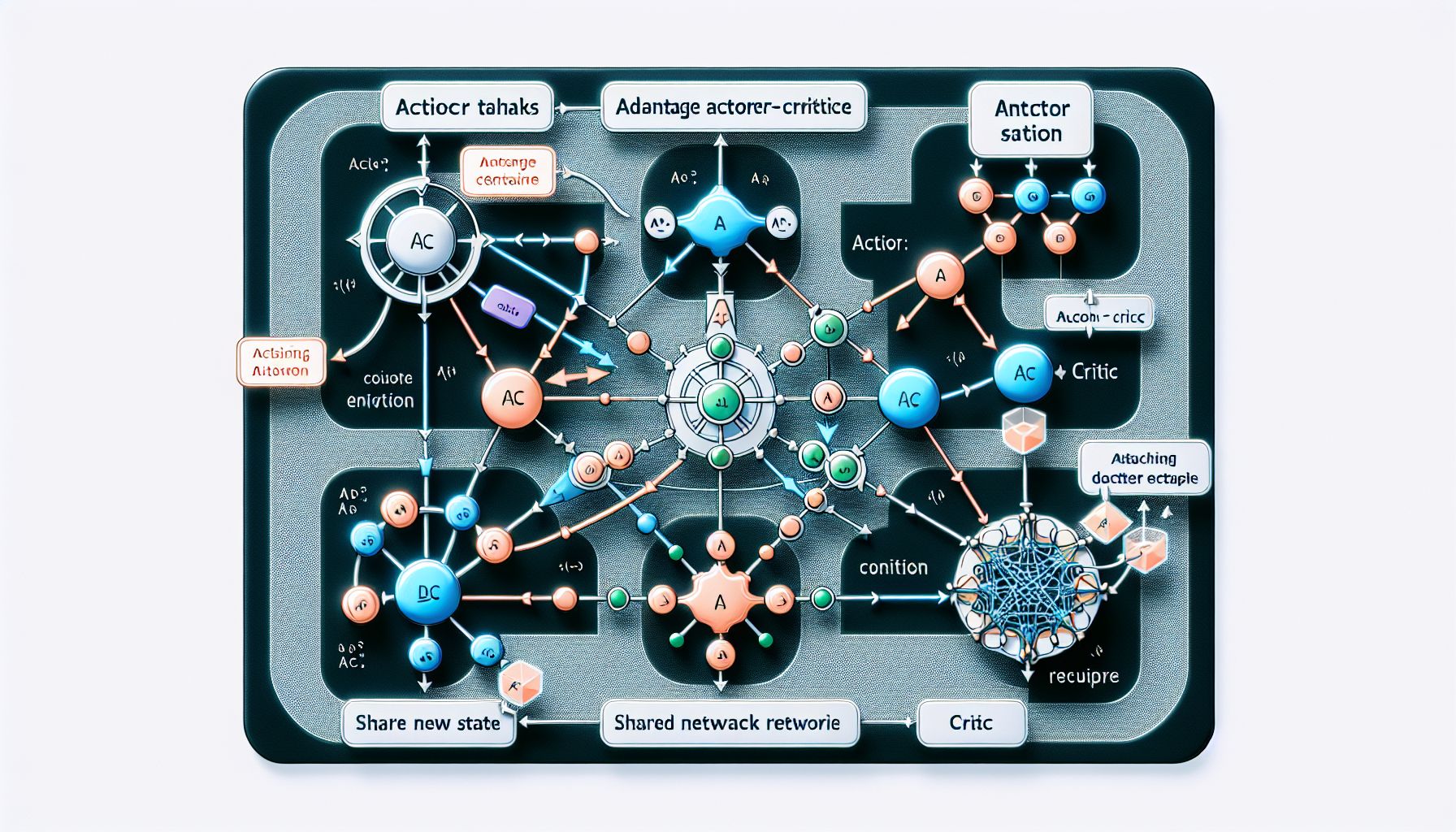📌 Let’s explore the topic in depth and see what insights we can uncover.
⚡ “Ever wondered how to train an AI to master games like chess, poker, or even Starcraft? Explore the dynamic duo of Advantage Actor-Critic (A2C) and Shared Neural Network Architecture to turn your AI from a newbie to the grandmaster!”
Welcome to the magical world of Reinforcement Learning (RL)! 🎩🐇 This arena of machine learning is teeming with fascinating concepts and innovative implementations, all designed to help our machines learn from their environment and make optimal decisions. One such technique that has been creating quite a buzz in the RL sphere is the Advantage Actor-Critic (A2C) method with shared neural network architecture. It’s like a magician’s twin act, where the Actor and the Critic work in tandem, sharing and leveraging each other’s strengths to create an outstanding performance. 🎭 In this post, we will embark on a thrilling journey to understand this method, see how it works, and explore its benefits. So, fasten your seatbelts as we dive deep into the world of A2C with shared neural network architecture.
🎭 The Dynamic Duo: Actor and Critic

"Unleashing Power: A2C on Shared Neural Network Canvas"
Before we dive into the shared architecture, let’s first understand the two main characters in our story - the Actor and the Critic. In the realm of RL, the Actor is the decision-maker. It’s the one that takes actions based on the current state of the environment, a bit like a chess player deciding on the next move. The Critic, on the other hand, is the evaluator. It assesses the Actor’s moves and provides feedback, much like a chess coach analyzing the player’s moves. In the Advantage Actor-Critic method, both these roles are played by different parts of the same neural network. The Critic estimates the value function, while the Actor updates the policy distribution in the direction suggested by the Critic. This symbiotic relationship results in a more robust and efficient learning process.
🧩 The Shared Neural Network Architecture: A Jigsaw Puzzle
Imagine a jigsaw puzzle 🧩. Each piece, though unique and different, comes together to form a coherent image. That’s exactly how the shared neural network architecture works in A2C. It’s like a complex puzzle where the Actor and the Critic, though operating separately, share a common backbone network. This shared architecture exploits the common features between the value and policy functions, thereby reducing the total number of parameters in the model. It’s a smart move that’s akin to two friends sharing notes and resources to prepare for the same exam. They leverage each other’s strengths, cover more ground, and perform better. That’s exactly what the Actor and Critic do in the shared architecture. The shared architecture involves two separate output layers - one for the Actor and one for the Critic - that sit on top of a shared feature extraction layer. This shared layer represents the common features between the value function (estimated by the Critic) and the policy function (updated by the Actor).
# Pythonic representation of shared architecture
shared_layer = SharedFeatureExtractionLayer(input)
actor_output = ActorLayer(shared_layer)
critic_output = CriticLayer(shared_layer)
The Actor and Critic, thus, work together, learning and improving from each other’s feedback in a synchronous and harmonious way.
🎖 The Spotlight on Advantages
In the A2C method, the spotlight is on the ‘Advantage’ part. The Advantage function measures how much better an action is compared to the average action in a given state. It’s like a performance review that measures an employee’s performance against the average performance of the team.
The Advantage function in A2C helps in reducing the variance of the gradient estimate, which in turn improves the learning stability and efficiency. It’s calculated as the difference between the actual return and the estimated value of the state, represented as A(s, a) = Q(s, a) - V(s) in mathematical terms.
In the shared neural network architecture, the Critic’s role is to estimate this Advantage function, which the Actor then uses to update the policy distribution. This symbiotic use of the Advantage function further enhances the performance of the A2C method.
🏆 The Benefits of A2C with Shared Neural Network Architecture
The A2C method with shared neural network architecture brings several benefits to the table:
Efficiency
By sharing a common feature extraction layer, the Actor and Critic can learn more efficiently, leveraging each other’s strengths.
Robustness
The use of the Advantage function reduces the variance of the gradient estimate, leading to more stable and robust learning.
Scalability
The shared architecture reduces the total number of parameters in the model, making it more scalable and manageable.
Performance
The A2C method outperforms many other RL methods, especially in complex environments with high-dimensional action spaces.
🧭 Conclusion
The Advantage Actor-Critic with shared neural network architecture is like a power-packed duo act, leveraging the strengths of both the Actor and the Critic to deliver an impressive performance in the field of Reinforcement Learning. From efficiency and robustness to scalability and performance, the benefits of this method are manifold. So, the next time you’re working on an RL problem, remember this dynamic duo and their magical act. You might just find that this is the magic trick you were looking for to make your machine learning models learn better and perform more effectively. So, let the magic of A2C with shared neural network architecture enchant you and lead you to new heights in your RL journey. After all, in the world of Reinforcement Learning, the magic is in the learning! 🎩🔮🐇
🤖 Stay tuned as we decode the future of innovation!
